
parea-sdk-py
Python SDK for experimenting, testing, evaluating & monitoring LLM-powered applications - Parea AI (YC S23)
Stars: 59
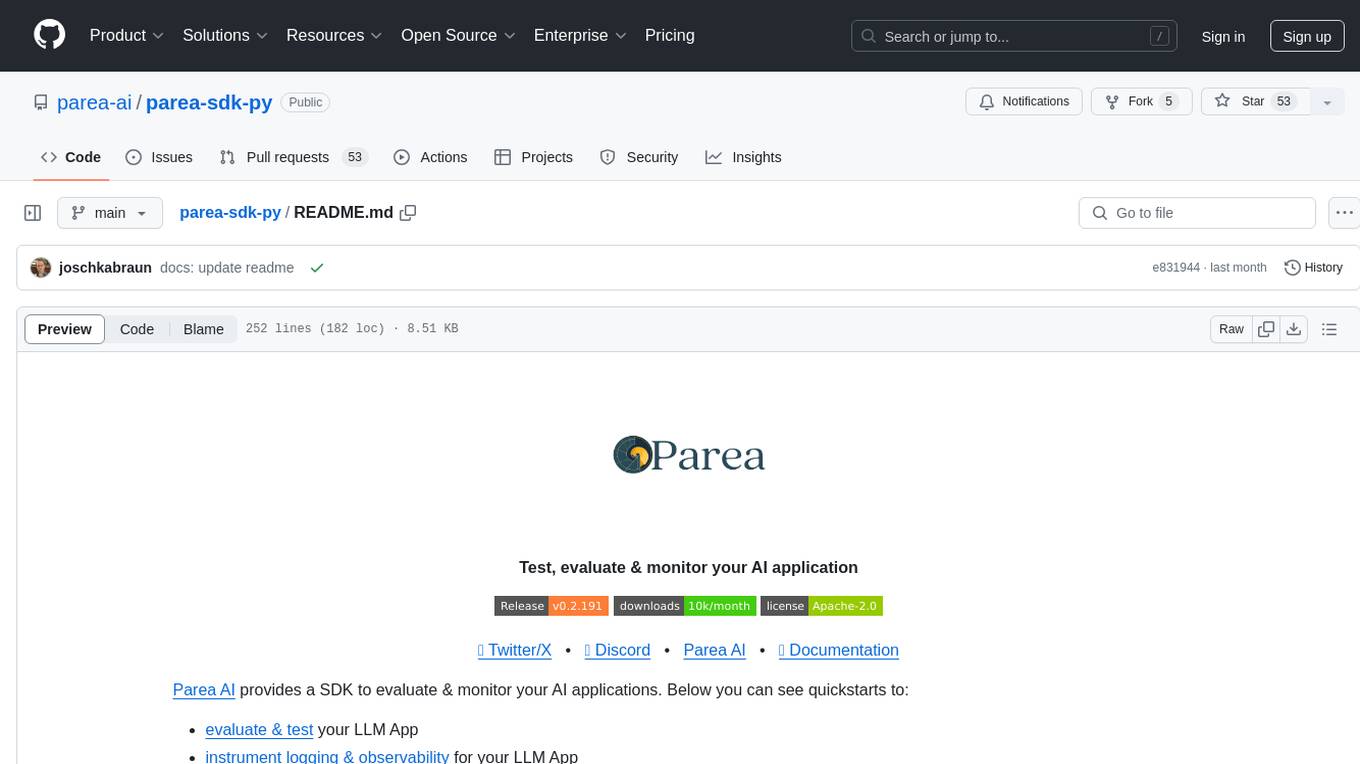
Parea AI provides a SDK to evaluate & monitor AI applications. It allows users to test, evaluate, and monitor their AI models by defining and running experiments. The SDK also enables logging and observability for AI applications, as well as deploying prompts to facilitate collaboration between engineers and subject-matter experts. Users can automatically log calls to OpenAI and Anthropic, create hierarchical traces of their applications, and deploy prompts for integration into their applications.
README:
Test, evaluate & monitor your AI application
🐦 Twitter/X • 📢 Discord • Parea AI • 📙 Documentation
Parea AI provides a SDK to evaluate & monitor your AI applications. Below you can see quickstarts to:
- evaluate & test your LLM App
- instrument logging & observability for your LLM App
- deploying prompts to enable collaboration between engineers & subject-matter experts
Our full docs are here.
pip install -U parea-aior install with Poetry
poetry add parea-aiTesting your AI app means to execute it over a dataset and score it with an evaluation function. This is done in Parea by defining & running experiments. Below you can see can example of how to test a greeting bot with the Levenshtein distance metric.
from parea import Parea, trace
from parea.evals.general import levenshtein
p = Parea(api_key="<<PAREA_API_KEY>>") # replace with Parea AI API key
# use the trace decorator to score the output with the Levenshtein distance
@trace(eval_funcs=[levenshtein])
def greeting(name: str) -> str:
return f"Hello {name}"
data = [
{"name": "Foo", "target": "Hi Foo"},
{"name": "Bar", "target": "Hello Bar"},
]
p.experiment(
name="Greeting",
data=data,
func=greeting,
).run()In the snippet above, we used the trace decorator to capture any inputs & outputs of the function.
This decorator also enables to score the output by executing the levenshtein eval in the background.
Then, we defined an experiment via p.experiment to evaluate our function (greeting) over a dataset (here a list of dictionaries).
Finally, calling run will execute the experiment, and create a report of outputs, scores & traces for any sample of the dataset.
You can find a link to the executed experiment here. (todo: fill-in experiment)
Read more about how to write, run & analyze experiments in our docs.
By wrapping the respective clients, you can automatically log all your LLM calls to OpenAI & Anthropic.
Additionally, using the trace decorator you can create hierarchical traces of your LLM application to e.g. associate LLM calls with the retrieval step of a RAG pipeline.
You can see the full observability documentation here and our integrations into LangChain, Instructor, DSPy, LiteLLM & more here.
To automatically log any OpenAI call, you can wrap the OpenAI client with the Parea client using the wrap_openai_client method.
from openai import OpenAI
from parea import Parea
client = OpenAI(api_key="OPENAI_API_KEY")
# All you need to do is add these two lines
p = Parea(api_key="PAREA_API_KEY") # replace with your API key
p.wrap_openai_client(client)
response = client.chat.completions.create(
model="gpt-4o",
messages=[
{
"role": "user",
"content": "Write a Hello World program in Python using FastAPI.",
}
],
)
print(response.choices[0].message.content)To automatically log any Anthropic call, you can wrap the Anthropic client with the Parea client using the wrap_anthropic_client method.
import anthropic
from parea import Parea
p = Parea(api_key="PAREA_API_KEY") # replace with your API key
client = anthropic.Anthropic()
p.wrap_anthropic_client(client)
message = client.messages.create(
model="claude-3-opus-20240229",
max_tokens=1024,
messages=[
{
"role": "user",
"content": "Write a Hello World program in Python using FastAPI.",
}
],
)
print(message.content[0].text)By using the trace decorator, you can create hierarchical traces of your LLM application.
from openai import OpenAI
from parea import Parea, trace
client = OpenAI(api_key="OPENAI_API_KEY") # replace with your API key
p = Parea(api_key="PAREA_API_KEY") # replace with your API key
p.wrap_openai_client(client)
# We generally recommend creating a helper function to make LLM API calls.
def llm(messages: list[dict[str, str]]) -> str:
response = client.chat.completions.create(model="gpt-4o", messages=messages)
return response.choices[0].message.content
# This will give the Span the name of the function.
# Without the decorator the default name for all LLM call logs is `llm-openai`
@trace
def hello_world(lang: str, framework: str):
return llm([{"role": "user", "content": f"Write a Hello World program in {lang} using {framework}."}])
@trace
def critique_code(code: str):
return llm([{"role": "user", "content": f"How can we improve this code: \n {code}"}])
# Our top level function is called chain. By adding the trace decorator here,
# all sub-functions will automatically be logged and associated with this trace.
# Notice, you can also add metadata to the trace, we'll revisit this functionality later.
@trace(metadata={"purpose": "example"}, end_user_identifier="John Doe")
def chain(lang: str, framework: str) -> str:
return critique_code(hello_world(lang, framework))
print(chain("Python", "FastAPI"))Deployed prompts enable collaboration with non-engineers such as product managers & subject-matter experts. Users can iterate, refine & test prompts on Parea's playground. After tinkering, you can deploy that prompt which means that it is exposed via an API endpoint to integrate it into your application. Checkout our full docs here.
from parea import Parea
from parea.schemas.models import Completion, UseDeployedPrompt, CompletionResponse, UseDeployedPromptResponse
p = Parea(api_key="<PAREA_API_KEY>")
# You will find this deployment_id in the Parea dashboard
deployment_id = '<DEPLOYMENT_ID>'
# Assuming your deployed prompt's message is:
# {"role": "user", "content": "Write a hello world program using {{x}} and the {{y}} framework."}
inputs = {"x": "Golang", "y": "Fiber"}
# You can easily unpack a dictionary into an attrs class
test_completion = Completion(
**{
"deployment_id": deployment_id,
"llm_inputs": inputs,
"metadata": {"purpose": "testing"}
}
)
# By passing in my inputs, in addition to the raw message with unfilled variables {{x}} and {{y}},
# you we will also get the filled-in prompt:
# {"role": "user", "content": "Write a hello world program using Golang and the Fiber framework."}
test_get_prompt = UseDeployedPrompt(deployment_id=deployment_id, llm_inputs=inputs)
def main():
completion_response: CompletionResponse = p.completion(data=test_completion)
print(completion_response)
deployed_prompt: UseDeployedPromptResponse = p.get_prompt(data=test_get_prompt)
print("\n\n")
print(deployed_prompt)This project is licensed under the terms of the Apache Software License 2.0 license.
See LICENSE for more details.
@misc{parea-sdk,
author = {joel-parea-ai,joschkabraun},
title = {Parea python sdk},
year = {2023},
publisher = {GitHub},
journal = {GitHub repository},
howpublished = {\url{https://github.com/parea-ai/parea-sdk}}
}For Tasks:
Click tags to check more tools for each tasksFor Jobs:
Alternative AI tools for parea-sdk-py
Similar Open Source Tools

parea-sdk-py
Parea AI provides a SDK to evaluate & monitor AI applications. It allows users to test, evaluate, and monitor their AI models by defining and running experiments. The SDK also enables logging and observability for AI applications, as well as deploying prompts to facilitate collaboration between engineers and subject-matter experts. Users can automatically log calls to OpenAI and Anthropic, create hierarchical traces of their applications, and deploy prompts for integration into their applications.
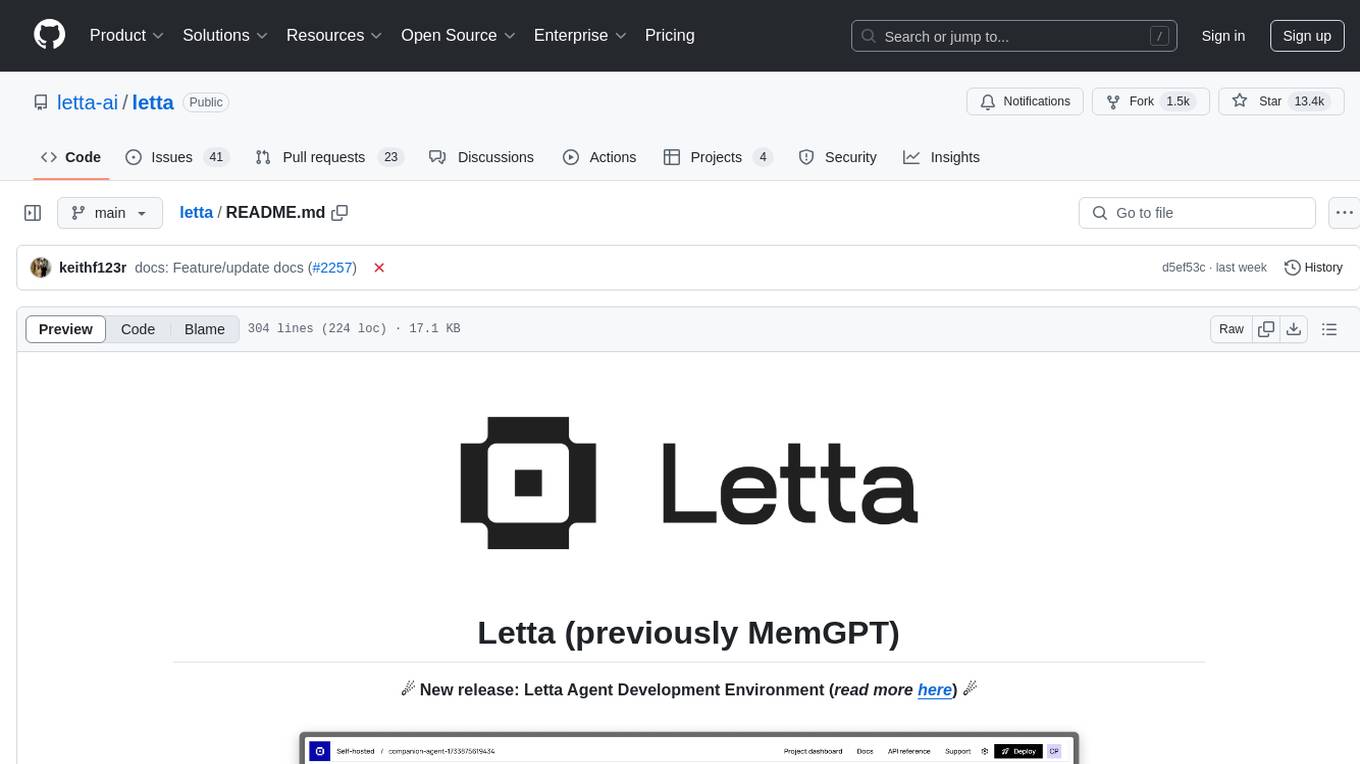
letta
Letta is an open source framework for building stateful LLM applications. It allows users to build stateful agents with advanced reasoning capabilities and transparent long-term memory. The framework is white box and model-agnostic, enabling users to connect to various LLM API backends. Letta provides a graphical interface, the Letta ADE, for creating, deploying, interacting, and observing with agents. Users can access Letta via REST API, Python, Typescript SDKs, and the ADE. Letta supports persistence by storing agent data in a database, with PostgreSQL recommended for data migrations. Users can install Letta using Docker or pip, with Docker defaulting to PostgreSQL and pip defaulting to SQLite. Letta also offers a CLI tool for interacting with agents. The project is open source and welcomes contributions from the community.
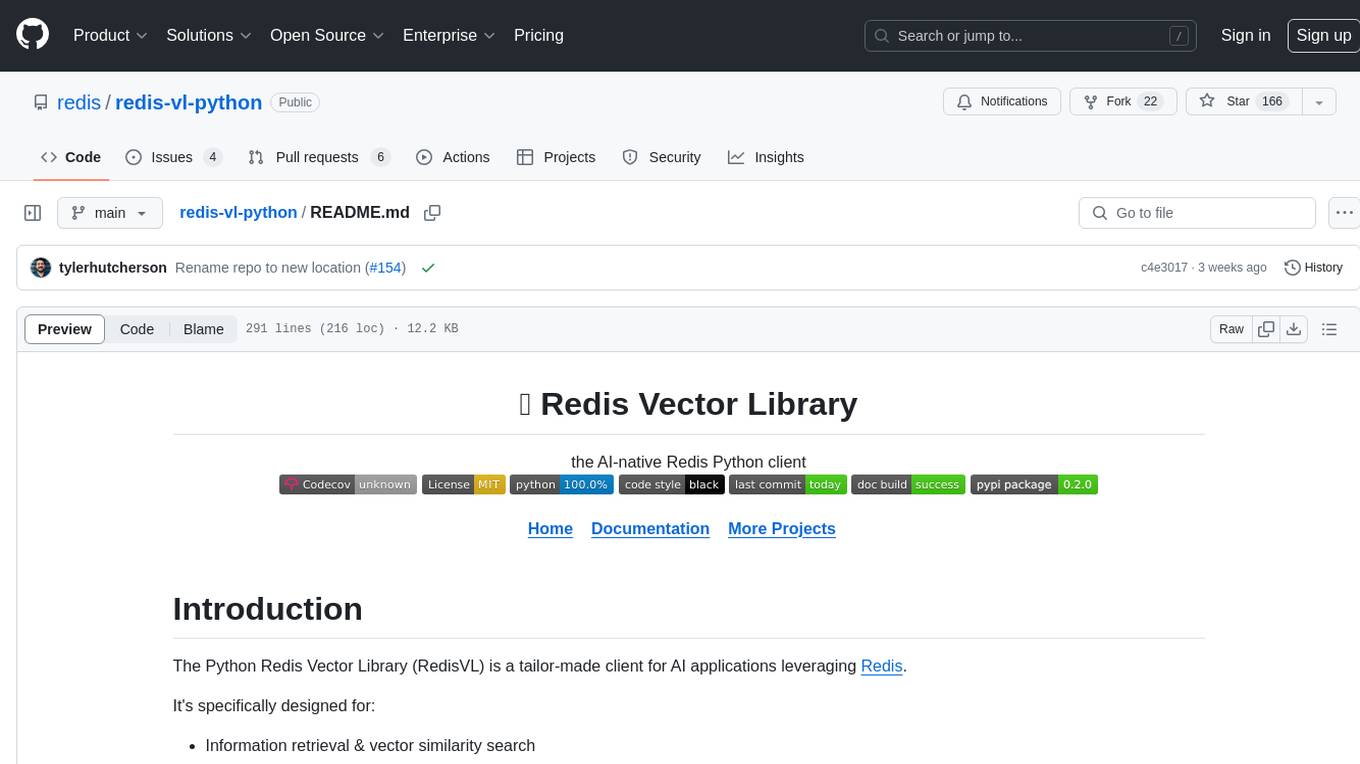
redis-vl-python
The Python Redis Vector Library (RedisVL) is a tailor-made client for AI applications leveraging Redis. It enhances applications with Redis' speed, flexibility, and reliability, incorporating capabilities like vector-based semantic search, full-text search, and geo-spatial search. The library bridges the gap between the emerging AI-native developer ecosystem and the capabilities of Redis by providing a lightweight, elegant, and intuitive interface. It abstracts the features of Redis into a grammar that is more aligned to the needs of today's AI/ML Engineers or Data Scientists.
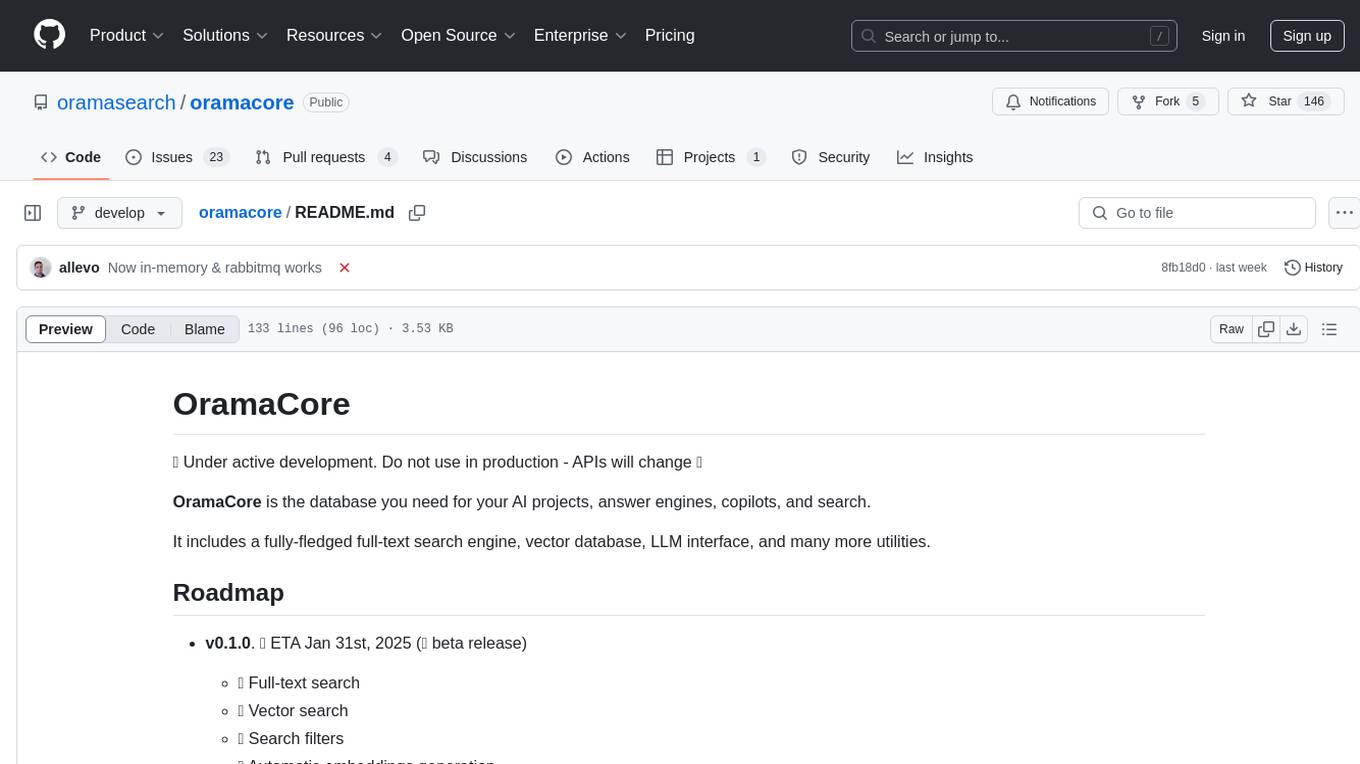
oramacore
OramaCore is a database designed for AI projects, answer engines, copilots, and search functionalities. It offers features such as a full-text search engine, vector database, LLM interface, and various utilities. The tool is currently under active development and not recommended for production use due to potential API changes. OramaCore aims to provide a comprehensive solution for managing data and enabling advanced search capabilities in AI applications.
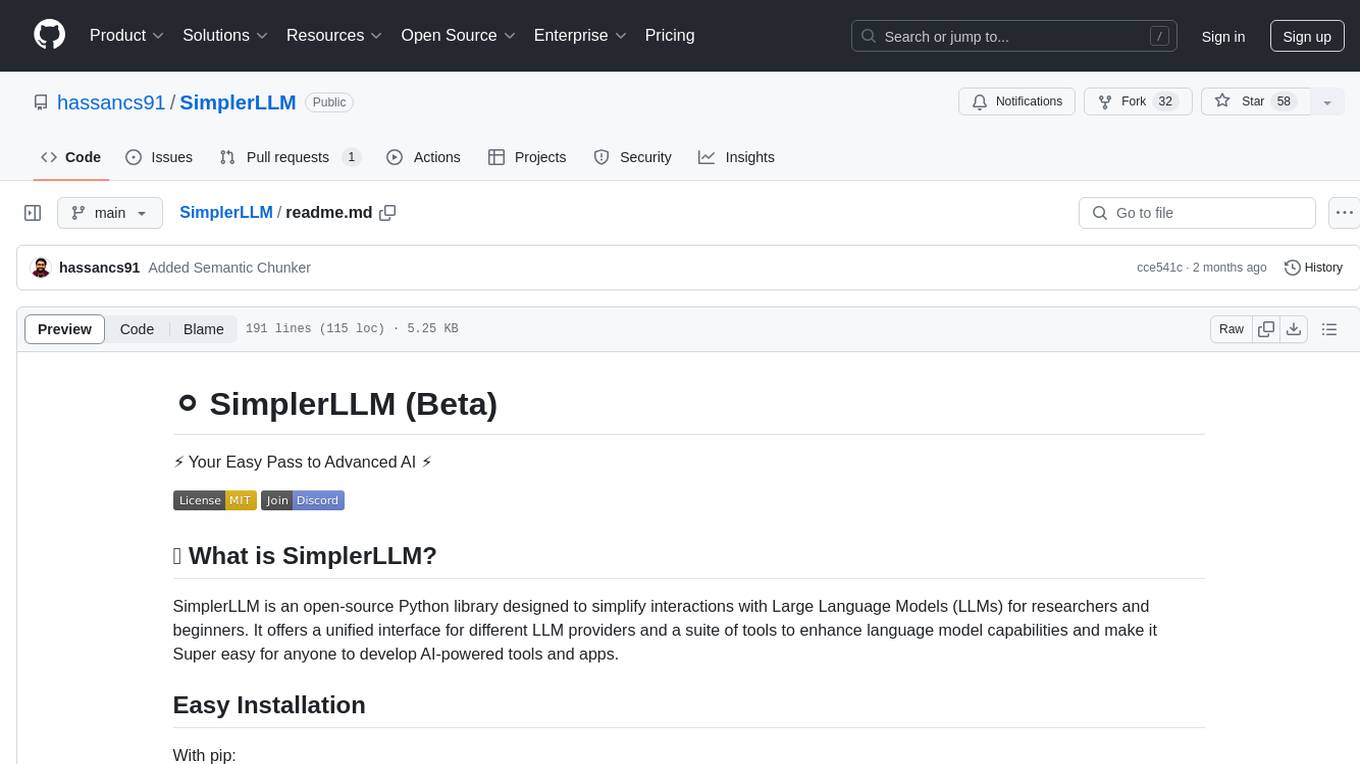
SimplerLLM
SimplerLLM is an open-source Python library that simplifies interactions with Large Language Models (LLMs) for researchers and beginners. It provides a unified interface for different LLM providers, tools for enhancing language model capabilities, and easy development of AI-powered tools and apps. The library offers features like unified LLM interface, generic text loader, RapidAPI connector, SERP integration, prompt template builder, and more. Users can easily set up environment variables, create LLM instances, use tools like SERP, generic text loader, calling RapidAPI APIs, and prompt template builder. Additionally, the library includes chunking functions to split texts into manageable chunks based on different criteria. Future updates will bring more tools, interactions with local LLMs, prompt optimization, response evaluation, GPT Trainer, document chunker, advanced document loader, integration with more providers, Simple RAG with SimplerVectors, integration with vector databases, agent builder, and LLM server.
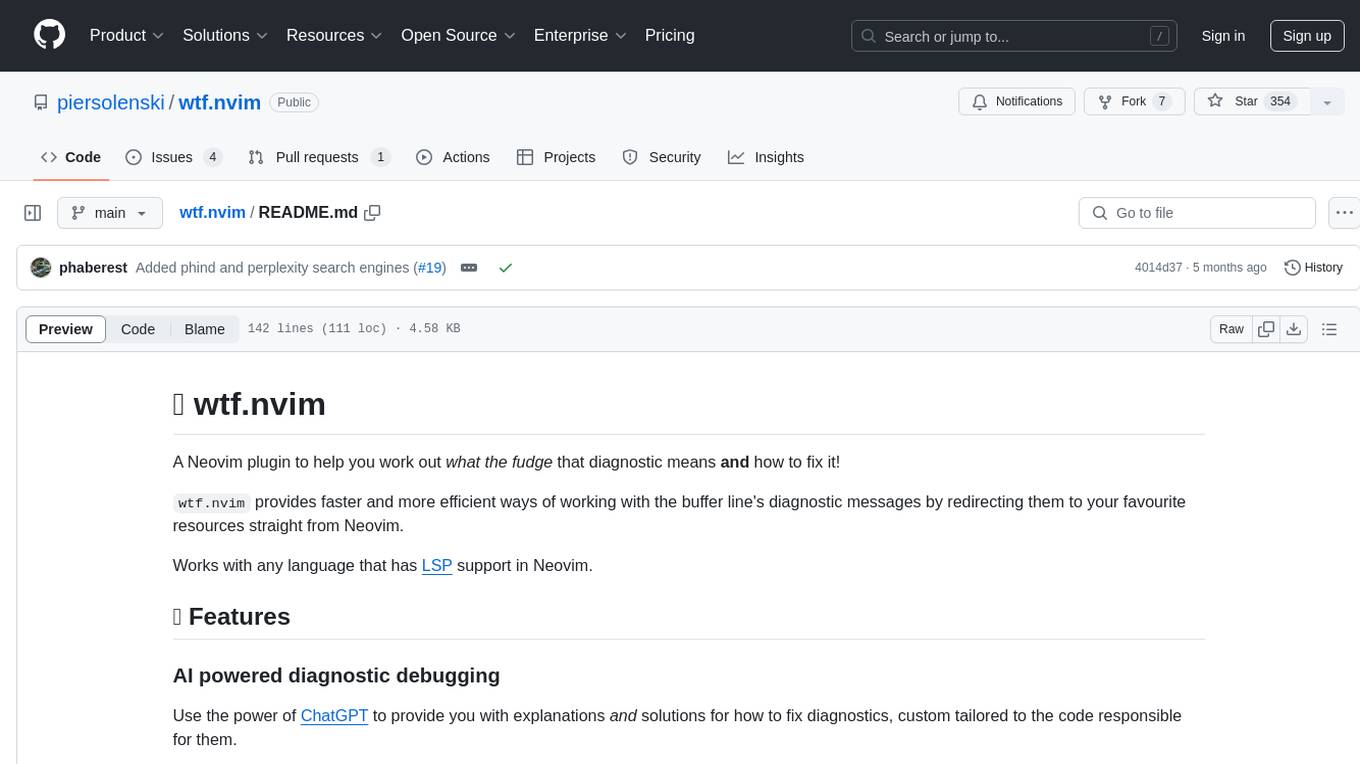
wtf.nvim
wtf.nvim is a Neovim plugin that enhances diagnostic debugging by providing explanations and solutions for code issues using ChatGPT. It allows users to search the web for answers directly from Neovim, making the debugging process faster and more efficient. The plugin works with any language that has LSP support in Neovim, offering AI-powered diagnostic assistance and seamless integration with various resources for resolving coding problems.
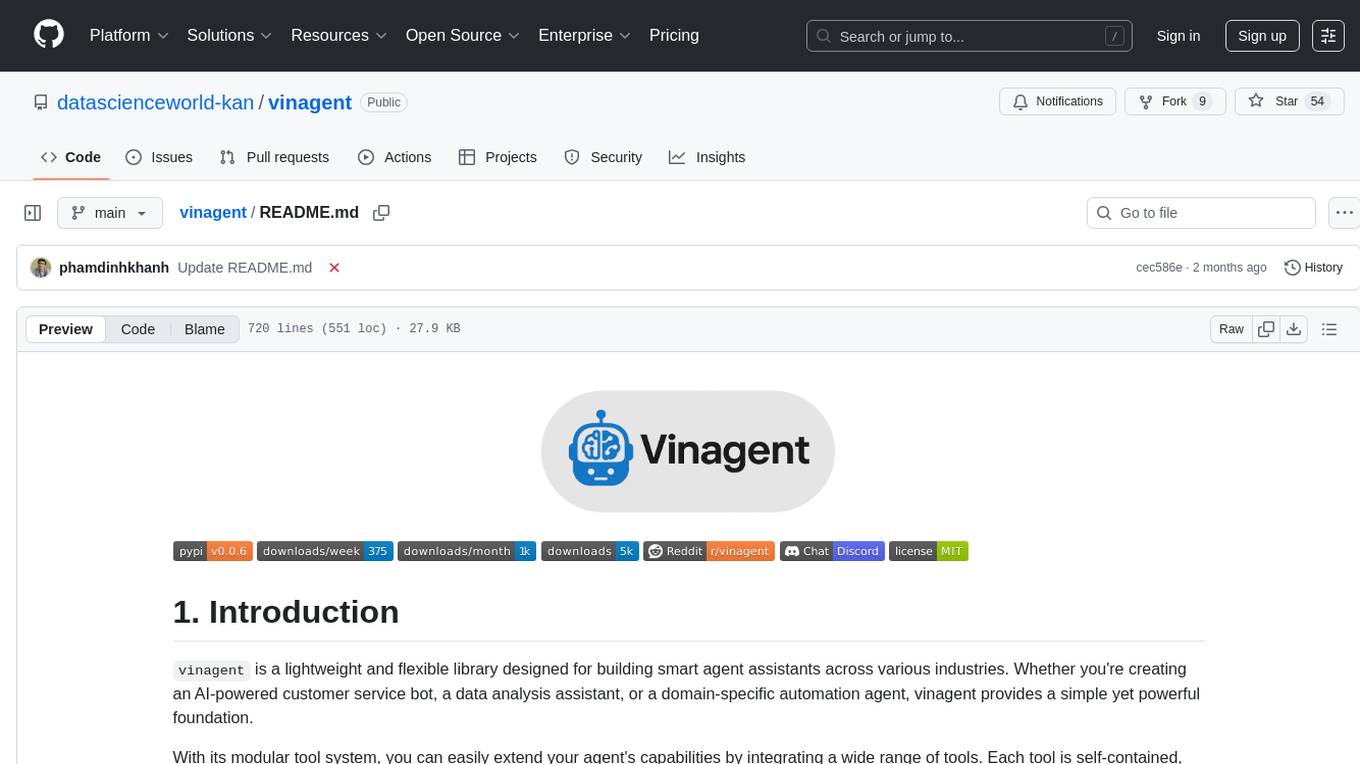
vinagent
Vinagent is a lightweight and flexible library designed for building smart agent assistants across various industries. It provides a simple yet powerful foundation for creating AI-powered customer service bots, data analysis assistants, or domain-specific automation agents. With its modular tool system, users can easily extend their agent's capabilities by integrating a wide range of tools that are self-contained, well-documented, and can be registered dynamically. Vinagent allows users to scale and adapt their agents to new tasks or environments effortlessly.
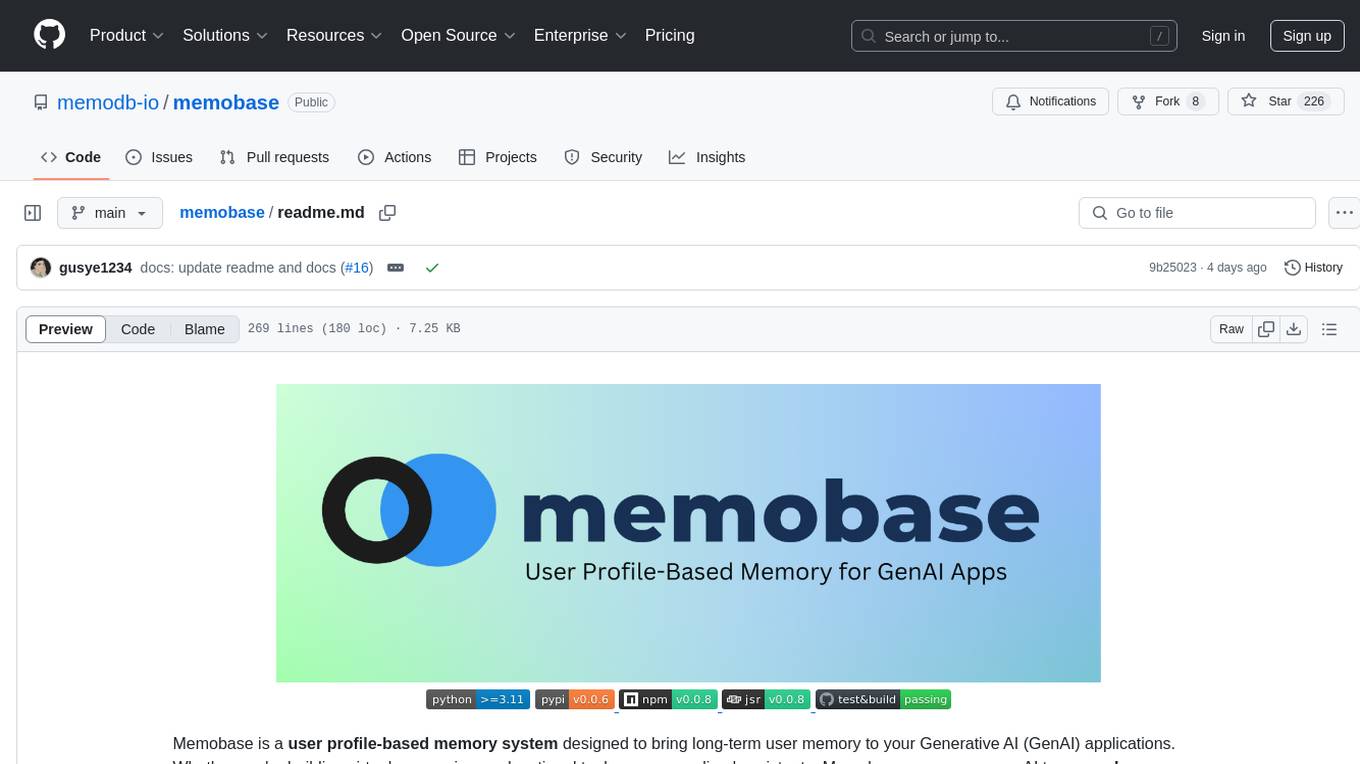
memobase
Memobase is a user profile-based memory system designed to enhance Generative AI applications by enabling them to remember, understand, and evolve with users. It provides structured user profiles, scalable profiling, easy integration with existing LLM stacks, batch processing for speed, and is production-ready. Users can manage users, insert data, get memory profiles, and track user preferences and behaviors. Memobase is ideal for applications that require user analysis, tracking, and personalized interactions.
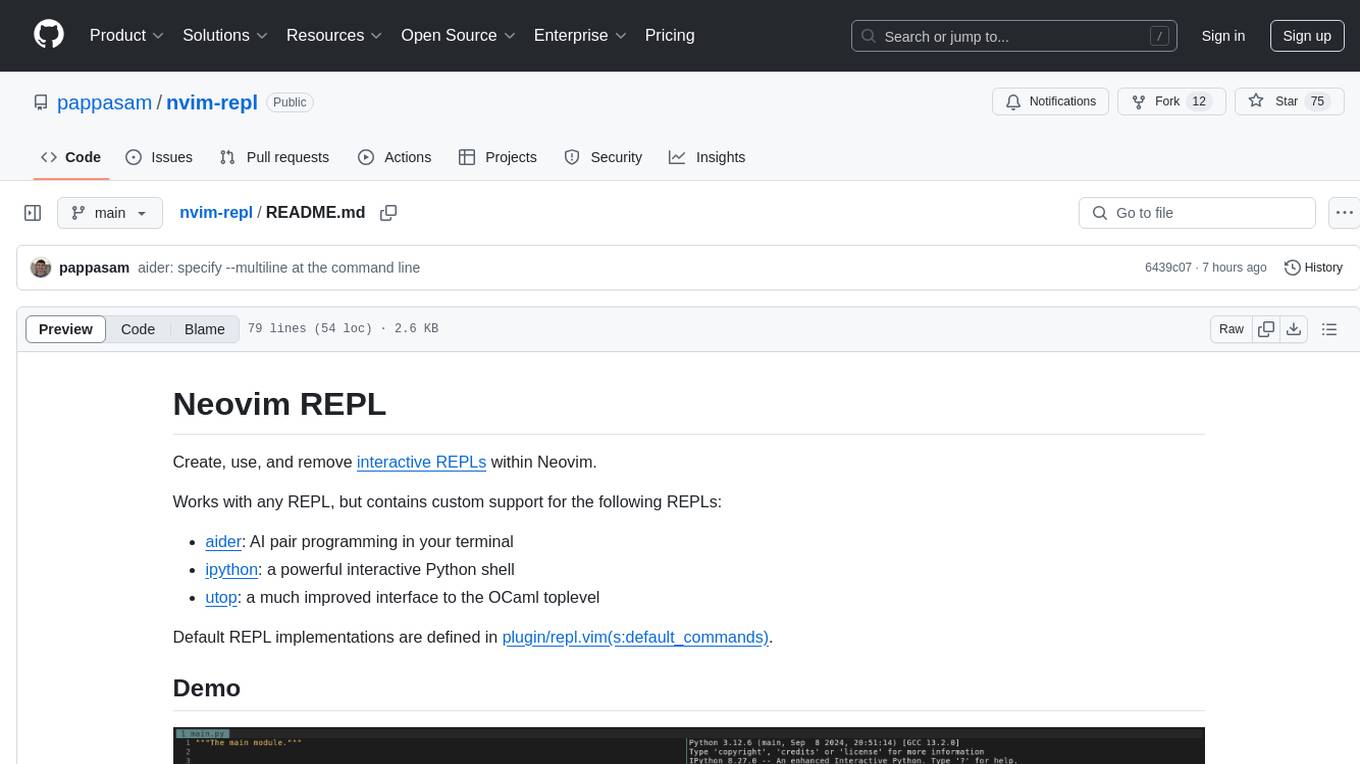
nvim-repl
Neovim REPL is a tool that allows users to create, use, and remove interactive Read-Eval-Print Loops (REPLs) within Neovim. It supports various REPLs including aider, ipython, and utop. Users can easily send code cells, lines, or visual selections to the REPL. The tool provides default settings and allows for customization through Lua configuration. Documentation is available within Neovim's help file. Users can seamlessly integrate Neovim with aider for AI pair programming by following recommended configurations.
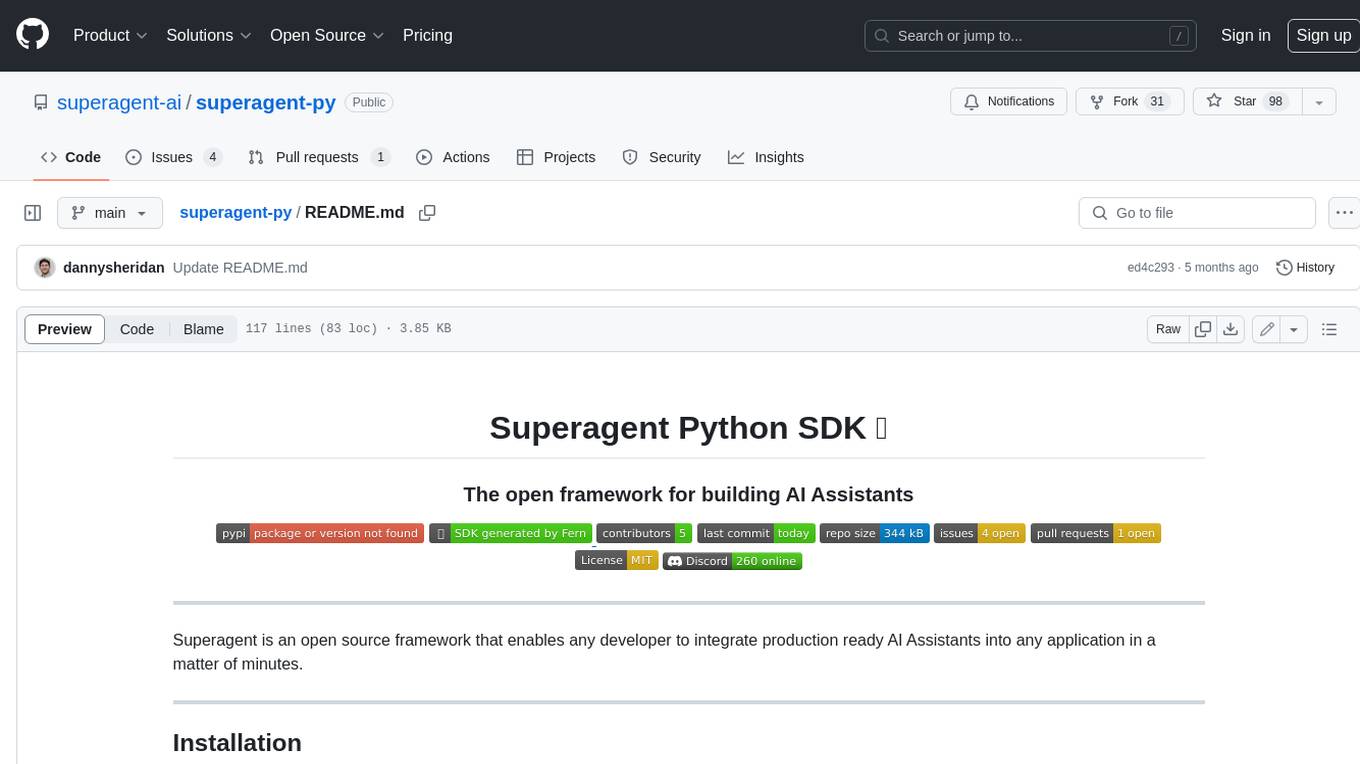
superagent-py
Superagent is an open-source framework that enables developers to integrate production-ready AI assistants into any application quickly and easily. It provides a Python SDK for interacting with the Superagent API, allowing developers to create, manage, and invoke AI agents. The SDK simplifies the process of building AI-powered applications, making it accessible to developers of all skill levels.
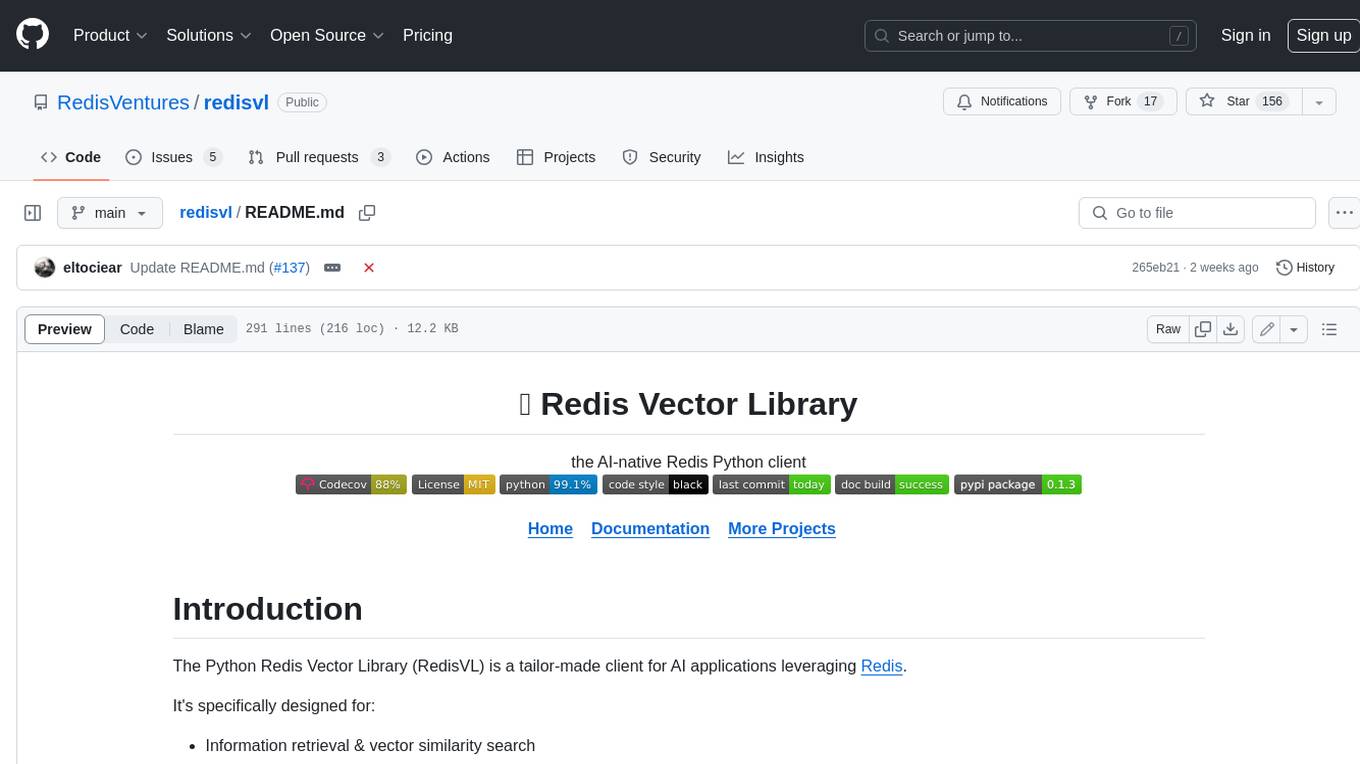
redisvl
Redis Vector Library (RedisVL) is a Python client library for building AI applications on top of Redis. It provides a high-level interface for managing vector indexes, performing vector search, and integrating with popular embedding models and providers. RedisVL is designed to make it easy for developers to build and deploy AI applications that leverage the speed, flexibility, and reliability of Redis.
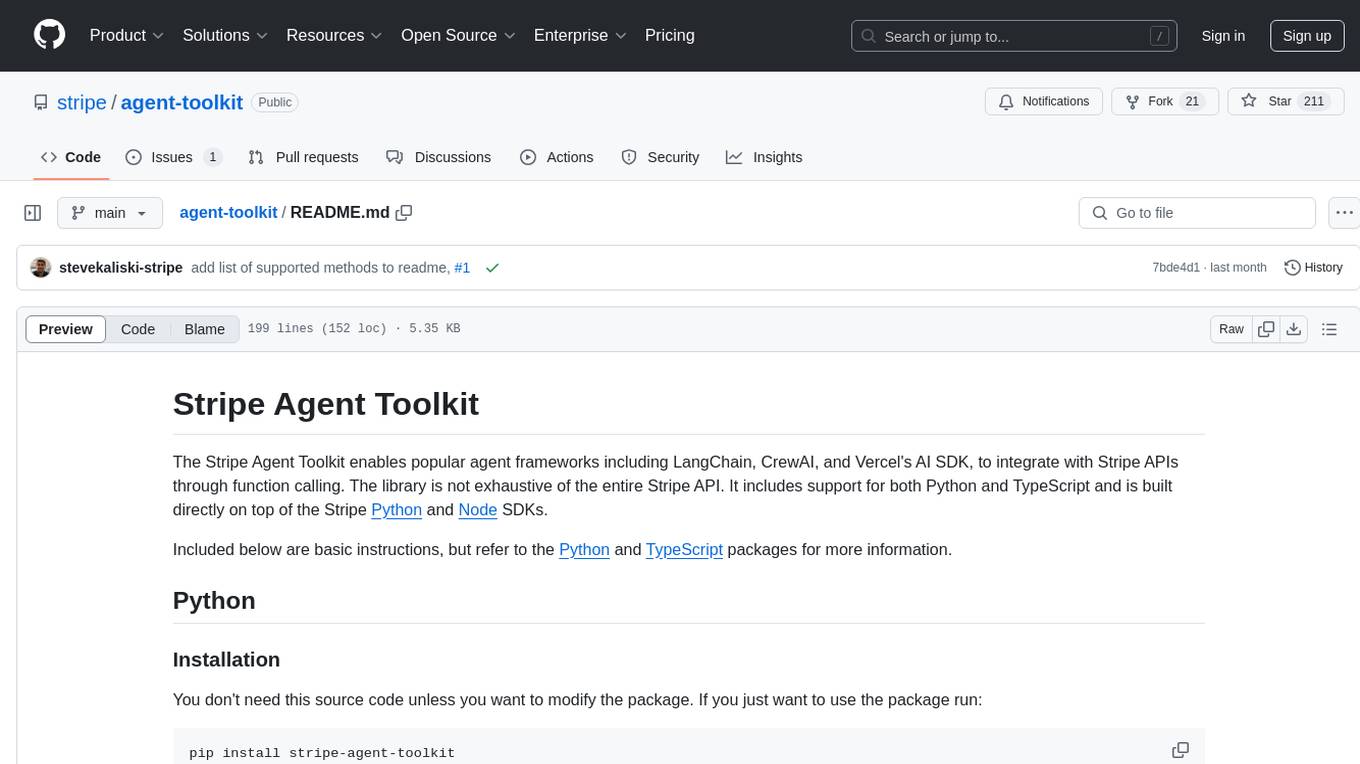
agent-toolkit
The Stripe Agent Toolkit enables popular agent frameworks to integrate with Stripe APIs through function calling. It includes support for Python and TypeScript, built on top of Stripe Python and Node SDKs. The toolkit provides tools for LangChain, CrewAI, and Vercel's AI SDK, allowing users to configure actions like creating payment links, invoices, refunds, and more. Users can pass the toolkit as a list of tools to agents for integration with Stripe. Context values can be provided for making requests, such as specifying connected accounts for API calls. The toolkit also supports metered billing for Vercel's AI SDK, enabling billing events submission based on customer ID and input/output meters.
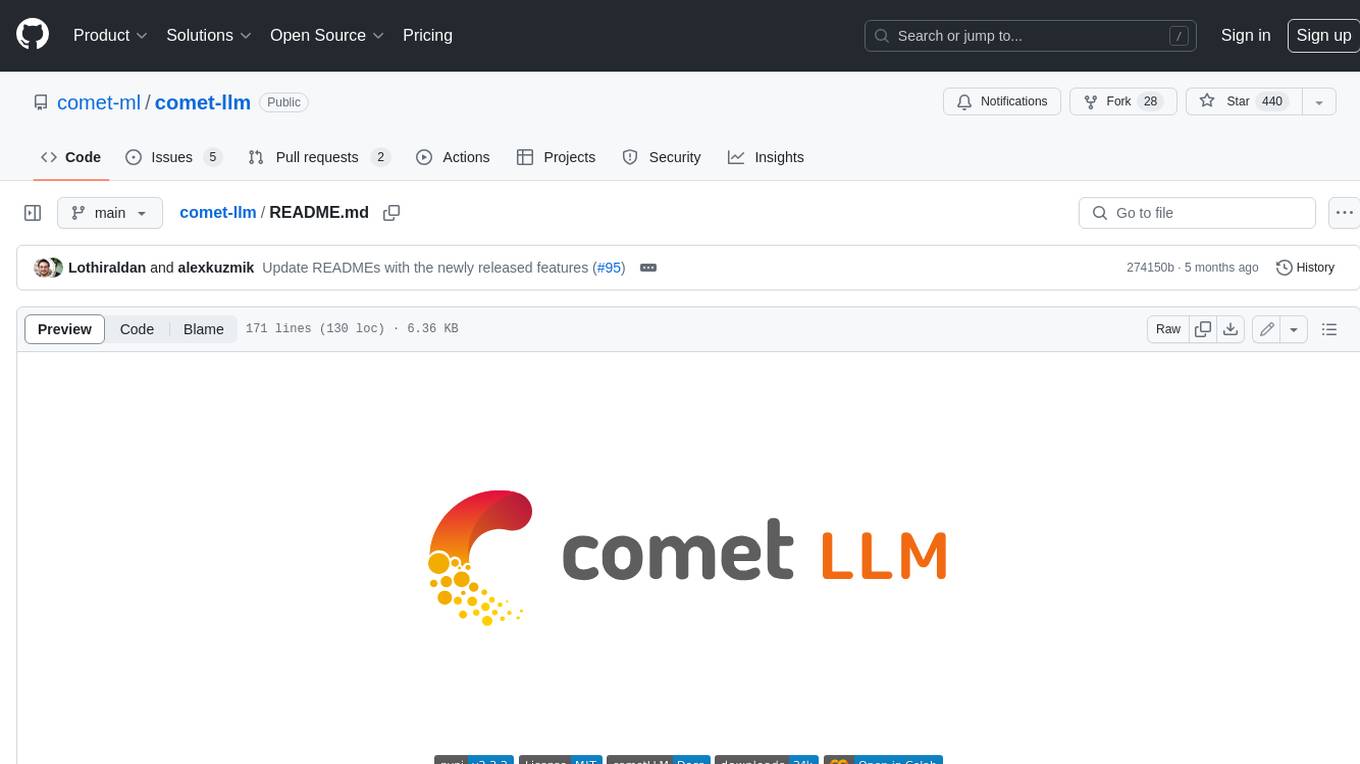
comet-llm
CometLLM is a tool to log and visualize your LLM prompts and chains. Use CometLLM to identify effective prompt strategies, streamline your troubleshooting, and ensure reproducible workflows!
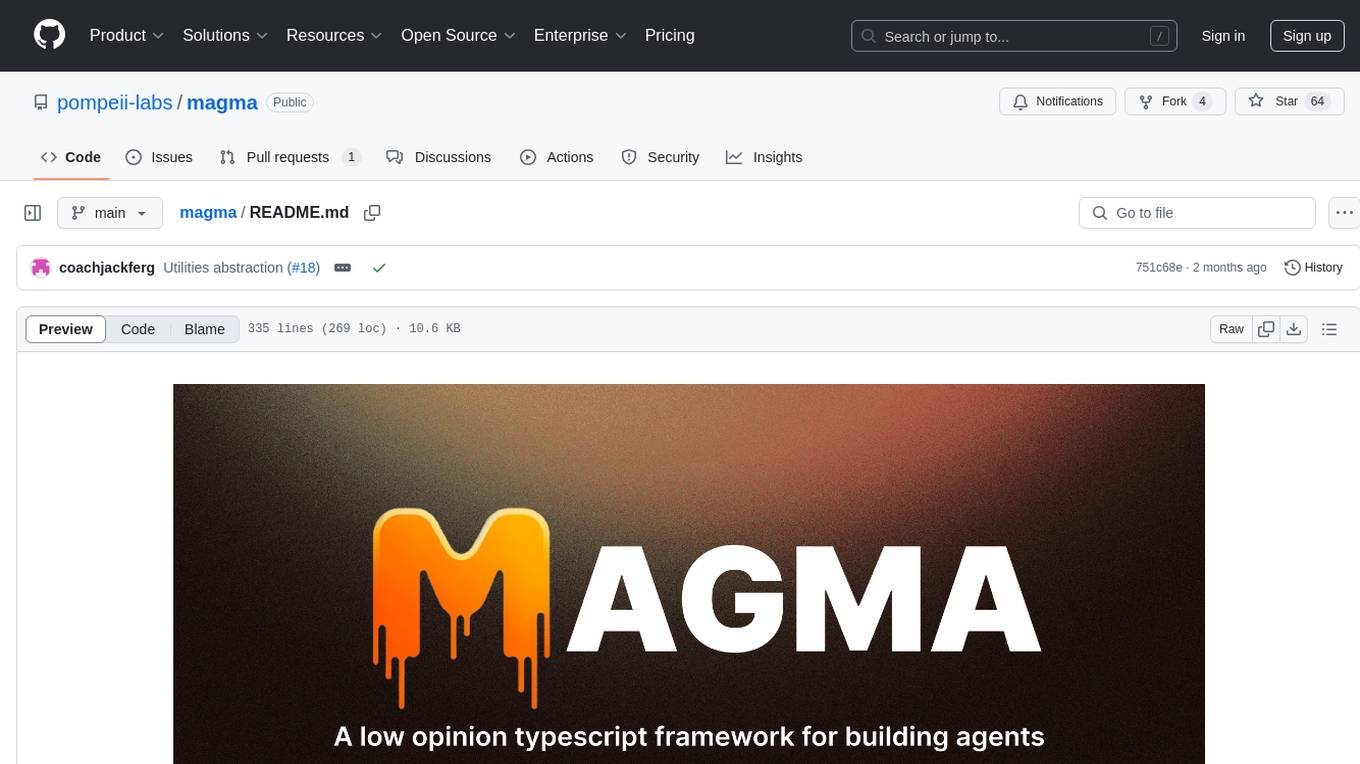
magma
Magma is a powerful and flexible framework for building scalable and efficient machine learning pipelines. It provides a simple interface for creating complex workflows, enabling users to easily experiment with different models and data processing techniques. With Magma, users can streamline the development and deployment of machine learning projects, saving time and resources.
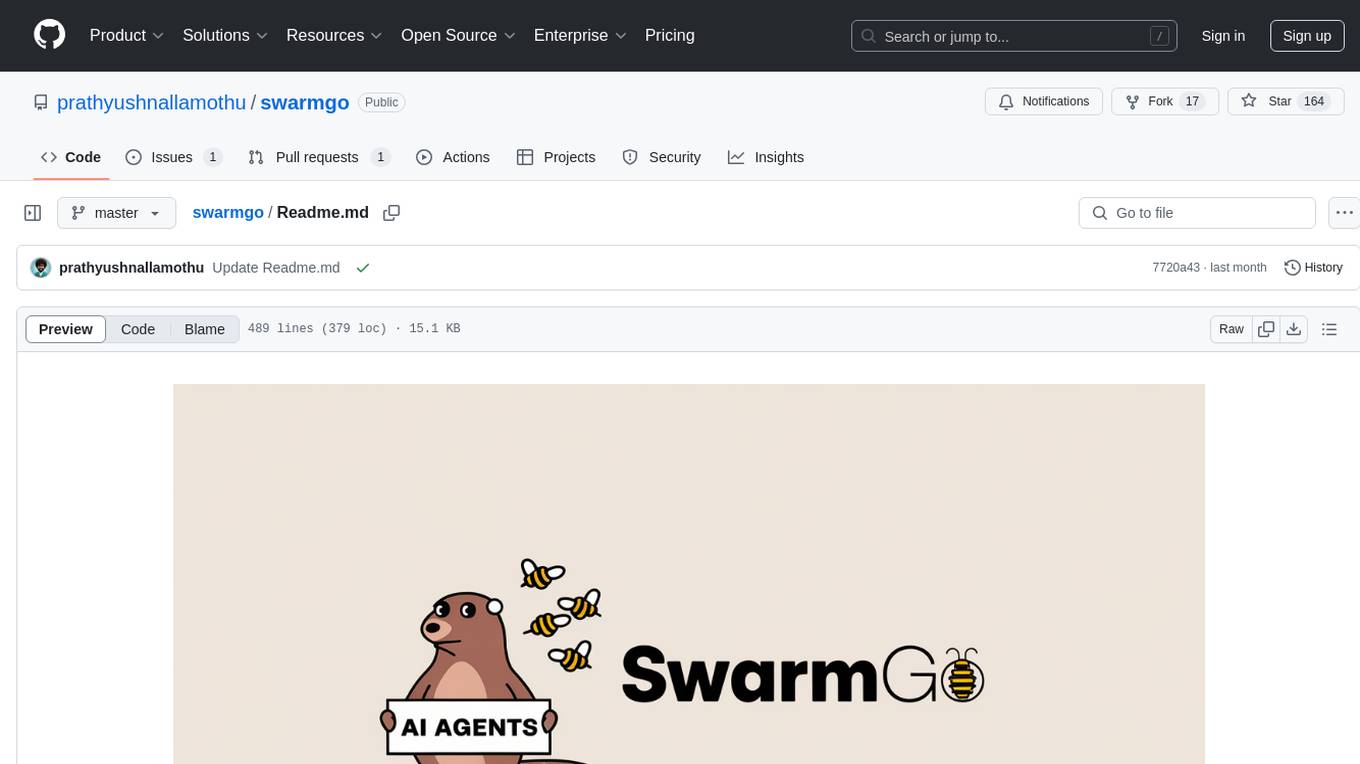
swarmgo
SwarmGo is a Go package designed to create AI agents capable of interacting, coordinating, and executing tasks. It focuses on lightweight agent coordination and execution, offering powerful primitives like Agents and handoffs. SwarmGo enables building scalable solutions with rich dynamics between tools and networks of agents, all while keeping the learning curve low. It supports features like memory management, streaming support, concurrent agent execution, LLM interface, and structured workflows for organizing and coordinating multiple agents.
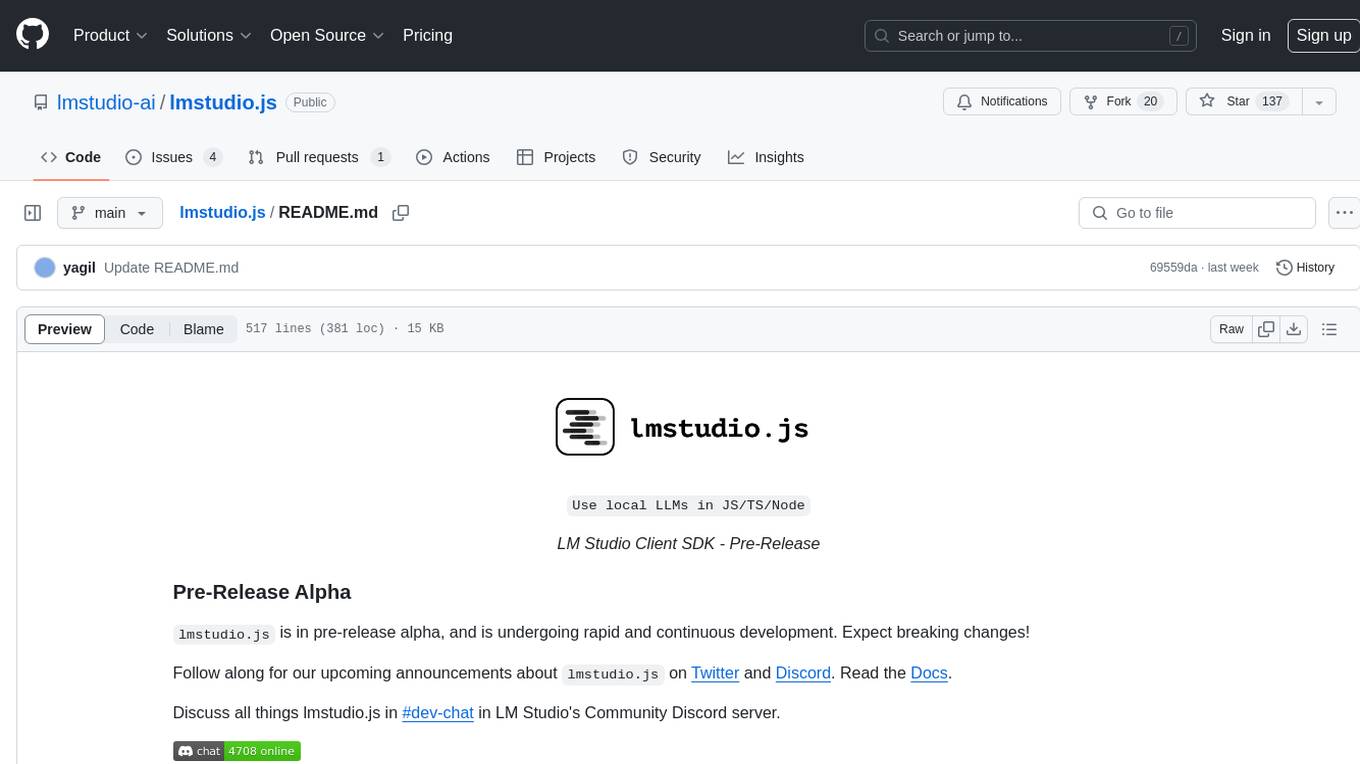
lmstudio.js
lmstudio.js is a pre-release alpha client SDK for LM Studio, allowing users to use local LLMs in JS/TS/Node. It is currently undergoing rapid development with breaking changes expected. Users can follow LM Studio's announcements on Twitter and Discord. The SDK provides API usage for loading models, predicting text, setting up the local LLM server, and more. It supports features like custom loading progress tracking, model unloading, structured output prediction, and cancellation of predictions. Users can interact with LM Studio through the CLI tool 'lms' and perform tasks like text completion, conversation, and getting prediction statistics.
For similar tasks

parea-sdk-py
Parea AI provides a SDK to evaluate & monitor AI applications. It allows users to test, evaluate, and monitor their AI models by defining and running experiments. The SDK also enables logging and observability for AI applications, as well as deploying prompts to facilitate collaboration between engineers and subject-matter experts. Users can automatically log calls to OpenAI and Anthropic, create hierarchical traces of their applications, and deploy prompts for integration into their applications.
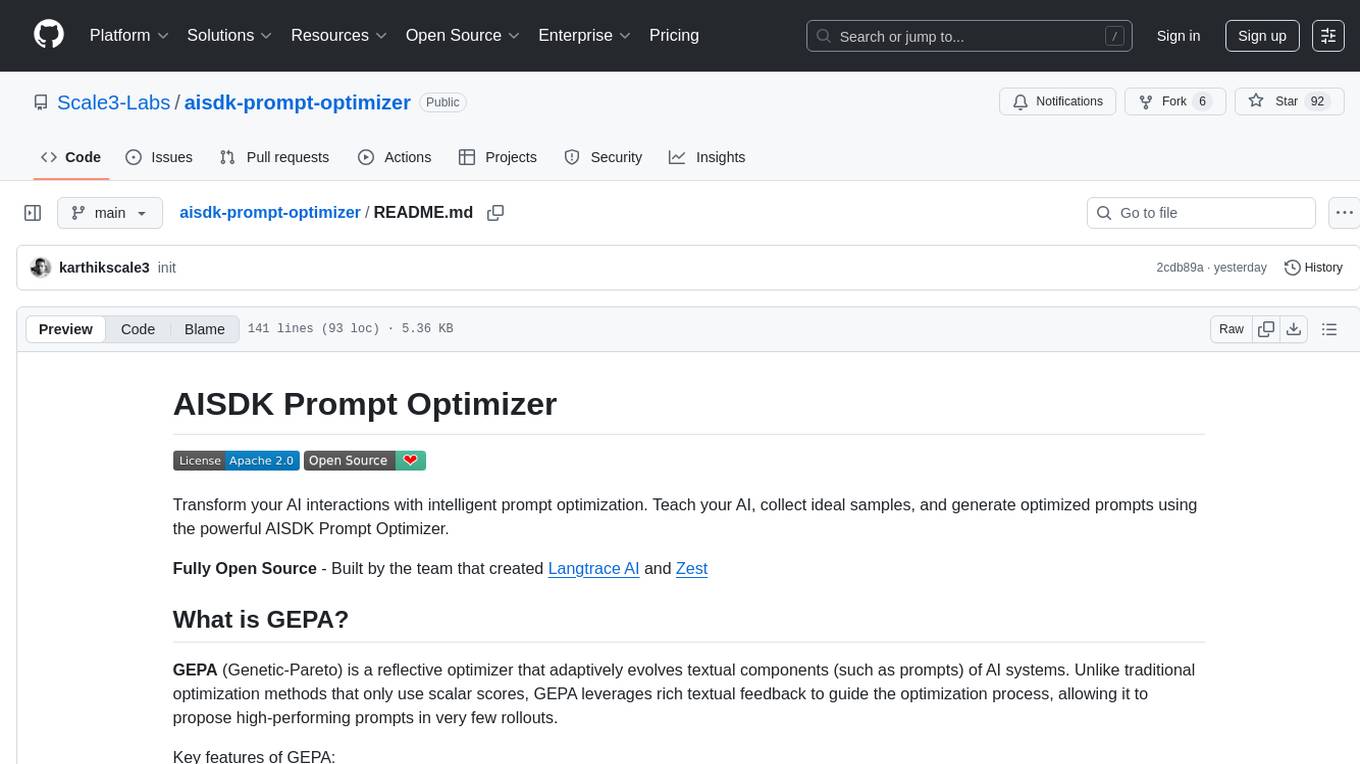
aisdk-prompt-optimizer
AISDK Prompt Optimizer is an open-source tool designed to transform AI interactions by optimizing prompts. It utilizes the GEPA reflective optimizer to evolve textual components of AI systems, providing features such as reflective prompt mutation, rich textual feedback, and Pareto-based selection. Users can teach their AI desired behaviors, collect ideal samples, run optimization to generate optimized prompts, and deploy the results in their applications. The tool leverages advanced optimization algorithms to guide AI through interactive conversations and refine prompt candidates for improved performance.
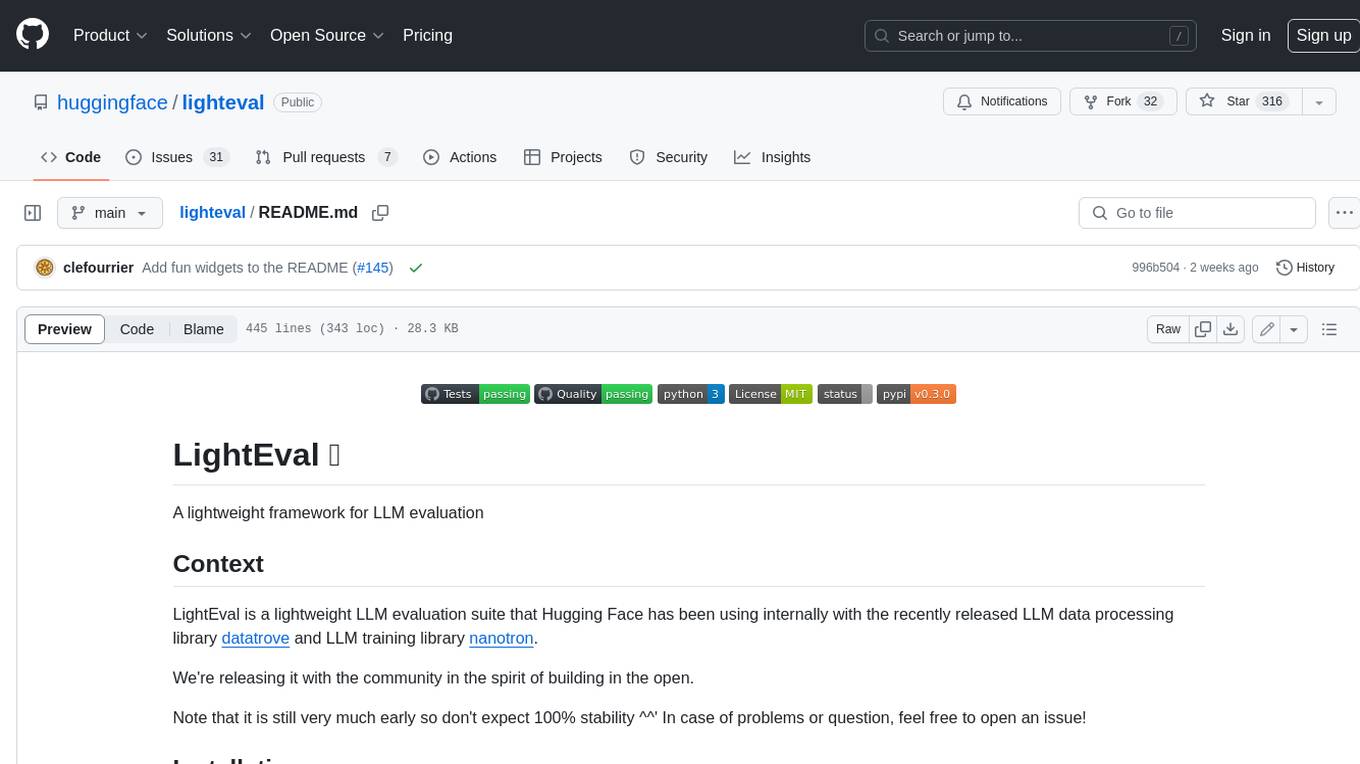
lighteval
LightEval is a lightweight LLM evaluation suite that Hugging Face has been using internally with the recently released LLM data processing library datatrove and LLM training library nanotron. We're releasing it with the community in the spirit of building in the open. Note that it is still very much early so don't expect 100% stability ^^' In case of problems or question, feel free to open an issue!
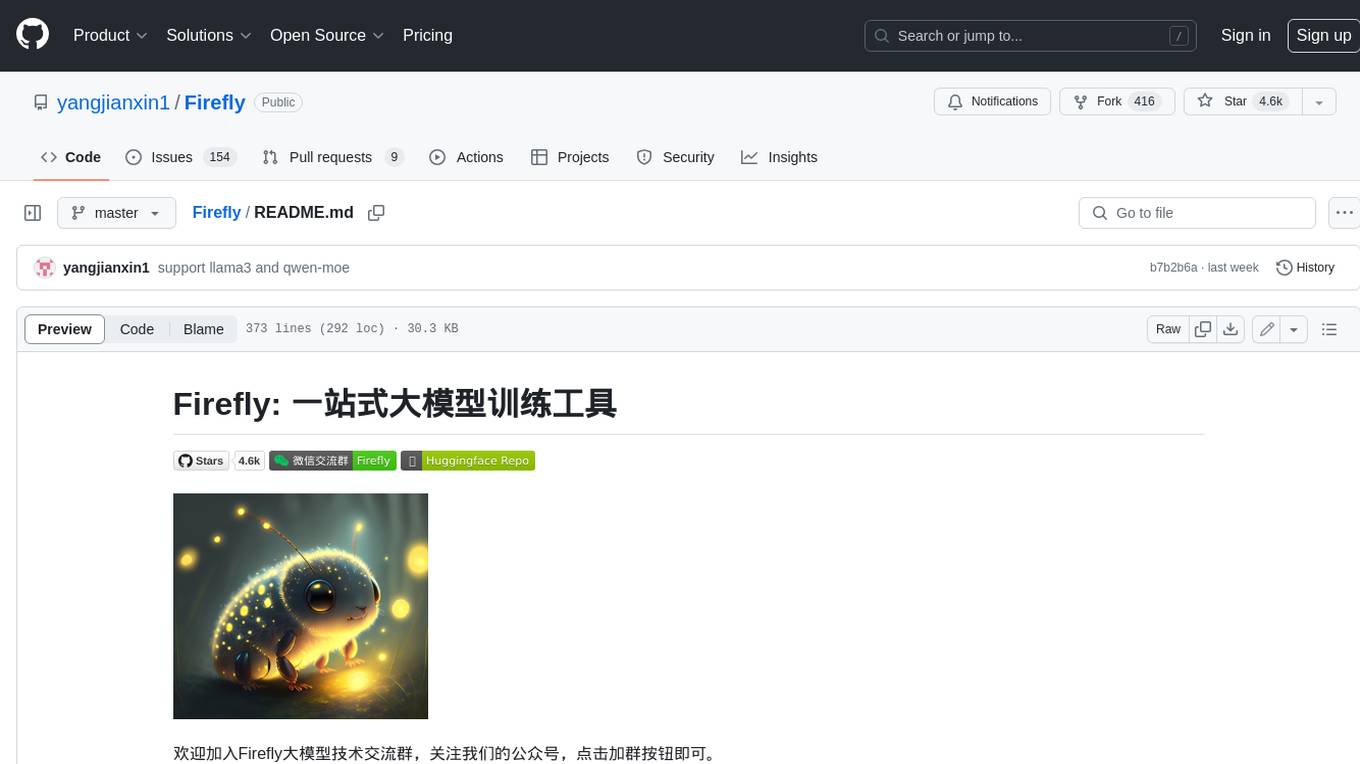
Firefly
Firefly is an open-source large model training project that supports pre-training, fine-tuning, and DPO of mainstream large models. It includes models like Llama3, Gemma, Qwen1.5, MiniCPM, Llama, InternLM, Baichuan, ChatGLM, Yi, Deepseek, Qwen, Orion, Ziya, Xverse, Mistral, Mixtral-8x7B, Zephyr, Vicuna, Bloom, etc. The project supports full-parameter training, LoRA, QLoRA efficient training, and various tasks such as pre-training, SFT, and DPO. Suitable for users with limited training resources, QLoRA is recommended for fine-tuning instructions. The project has achieved good results on the Open LLM Leaderboard with QLoRA training process validation. The latest version has significant updates and adaptations for different chat model templates.
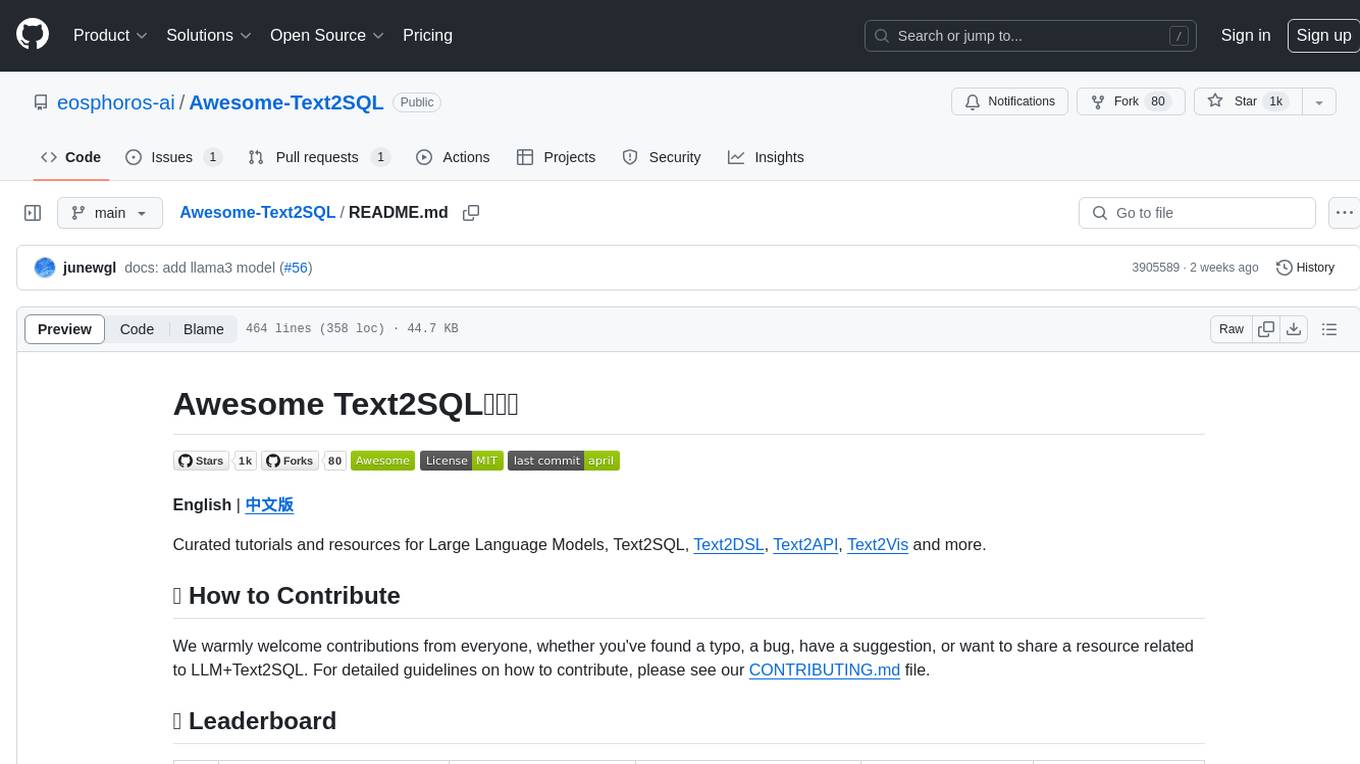
Awesome-Text2SQL
Awesome Text2SQL is a curated repository containing tutorials and resources for Large Language Models, Text2SQL, Text2DSL, Text2API, Text2Vis, and more. It provides guidelines on converting natural language questions into structured SQL queries, with a focus on NL2SQL. The repository includes information on various models, datasets, evaluation metrics, fine-tuning methods, libraries, and practice projects related to Text2SQL. It serves as a comprehensive resource for individuals interested in working with Text2SQL and related technologies.
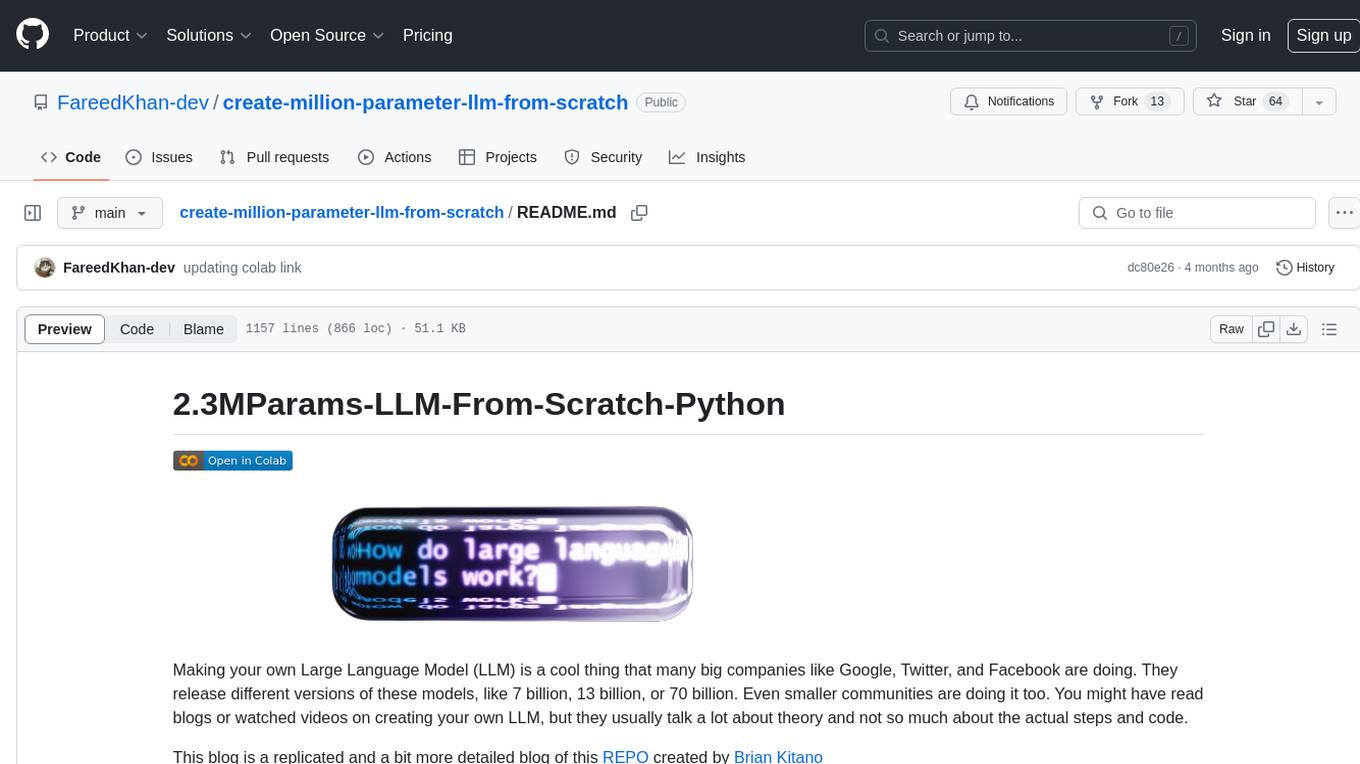
create-million-parameter-llm-from-scratch
The 'create-million-parameter-llm-from-scratch' repository provides a detailed guide on creating a Large Language Model (LLM) with 2.3 million parameters from scratch. The blog replicates the LLaMA approach, incorporating concepts like RMSNorm for pre-normalization, SwiGLU activation function, and Rotary Embeddings. The model is trained on a basic dataset to demonstrate the ease of creating a million-parameter LLM without the need for a high-end GPU.
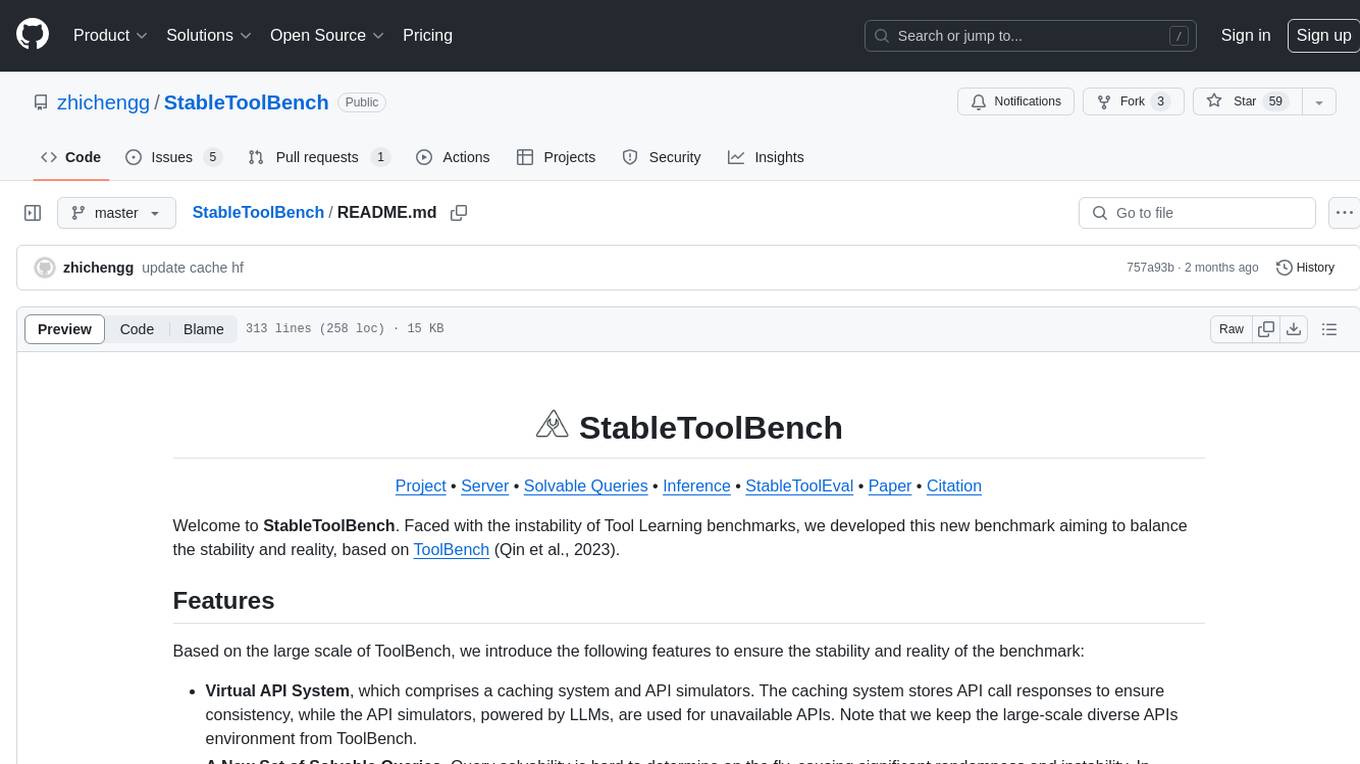
StableToolBench
StableToolBench is a new benchmark developed to address the instability of Tool Learning benchmarks. It aims to balance stability and reality by introducing features such as a Virtual API System with caching and API simulators, a new set of solvable queries determined by LLMs, and a Stable Evaluation System using GPT-4. The Virtual API Server can be set up either by building from source or using a prebuilt Docker image. Users can test the server using provided scripts and evaluate models with Solvable Pass Rate and Solvable Win Rate metrics. The tool also includes model experiments results comparing different models' performance.
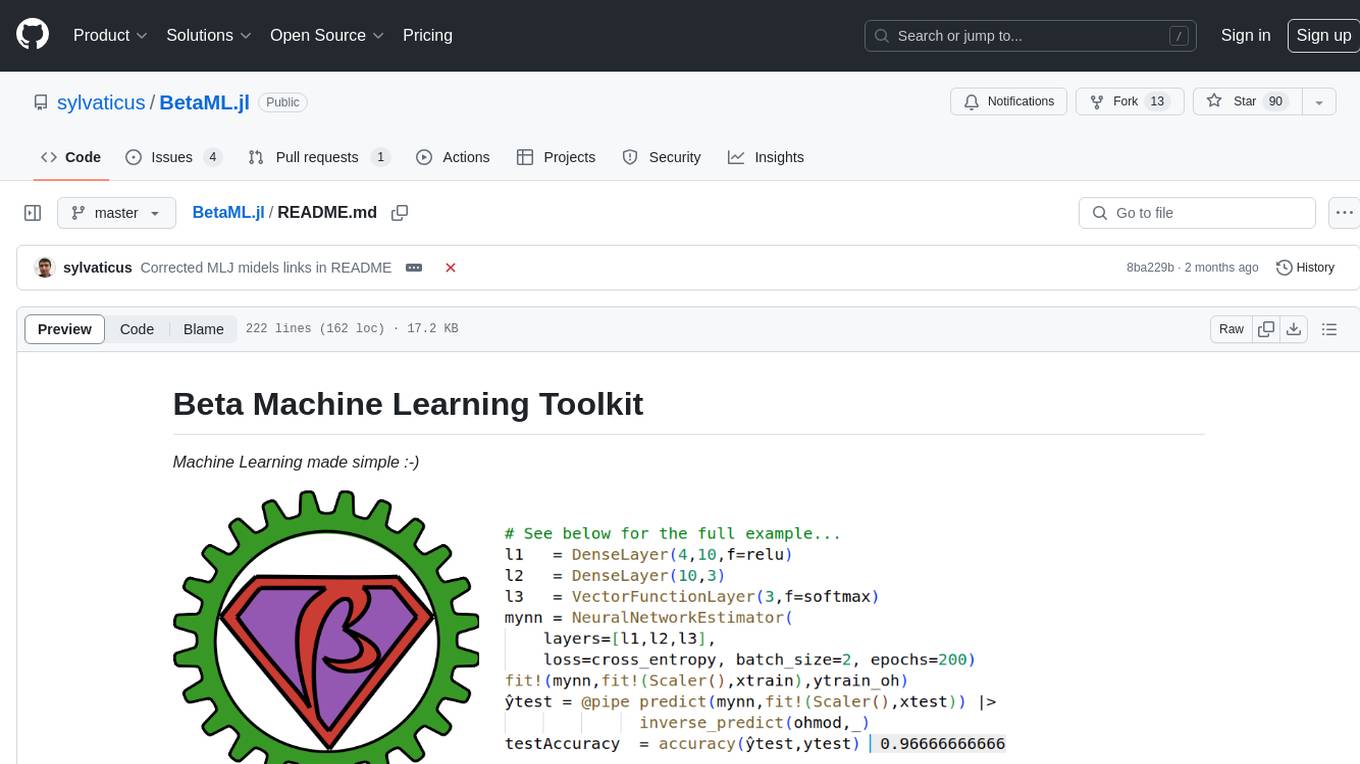
BetaML.jl
The Beta Machine Learning Toolkit is a package containing various algorithms and utilities for implementing machine learning workflows in multiple languages, including Julia, Python, and R. It offers a range of supervised and unsupervised models, data transformers, and assessment tools. The models are implemented entirely in Julia and are not wrappers for third-party models. Users can easily contribute new models or request implementations. The focus is on user-friendliness rather than computational efficiency, making it suitable for educational and research purposes.
For similar jobs

sweep
Sweep is an AI junior developer that turns bugs and feature requests into code changes. It automatically handles developer experience improvements like adding type hints and improving test coverage.

teams-ai
The Teams AI Library is a software development kit (SDK) that helps developers create bots that can interact with Teams and Microsoft 365 applications. It is built on top of the Bot Framework SDK and simplifies the process of developing bots that interact with Teams' artificial intelligence capabilities. The SDK is available for JavaScript/TypeScript, .NET, and Python.

ai-guide
This guide is dedicated to Large Language Models (LLMs) that you can run on your home computer. It assumes your PC is a lower-end, non-gaming setup.

classifai
Supercharge WordPress Content Workflows and Engagement with Artificial Intelligence. Tap into leading cloud-based services like OpenAI, Microsoft Azure AI, Google Gemini and IBM Watson to augment your WordPress-powered websites. Publish content faster while improving SEO performance and increasing audience engagement. ClassifAI integrates Artificial Intelligence and Machine Learning technologies to lighten your workload and eliminate tedious tasks, giving you more time to create original content that matters.

chatbot-ui
Chatbot UI is an open-source AI chat app that allows users to create and deploy their own AI chatbots. It is easy to use and can be customized to fit any need. Chatbot UI is perfect for businesses, developers, and anyone who wants to create a chatbot.

BricksLLM
BricksLLM is a cloud native AI gateway written in Go. Currently, it provides native support for OpenAI, Anthropic, Azure OpenAI and vLLM. BricksLLM aims to provide enterprise level infrastructure that can power any LLM production use cases. Here are some use cases for BricksLLM: * Set LLM usage limits for users on different pricing tiers * Track LLM usage on a per user and per organization basis * Block or redact requests containing PIIs * Improve LLM reliability with failovers, retries and caching * Distribute API keys with rate limits and cost limits for internal development/production use cases * Distribute API keys with rate limits and cost limits for students

uAgents
uAgents is a Python library developed by Fetch.ai that allows for the creation of autonomous AI agents. These agents can perform various tasks on a schedule or take action on various events. uAgents are easy to create and manage, and they are connected to a fast-growing network of other uAgents. They are also secure, with cryptographically secured messages and wallets.

griptape
Griptape is a modular Python framework for building AI-powered applications that securely connect to your enterprise data and APIs. It offers developers the ability to maintain control and flexibility at every step. Griptape's core components include Structures (Agents, Pipelines, and Workflows), Tasks, Tools, Memory (Conversation Memory, Task Memory, and Meta Memory), Drivers (Prompt and Embedding Drivers, Vector Store Drivers, Image Generation Drivers, Image Query Drivers, SQL Drivers, Web Scraper Drivers, and Conversation Memory Drivers), Engines (Query Engines, Extraction Engines, Summary Engines, Image Generation Engines, and Image Query Engines), and additional components (Rulesets, Loaders, Artifacts, Chunkers, and Tokenizers). Griptape enables developers to create AI-powered applications with ease and efficiency.




